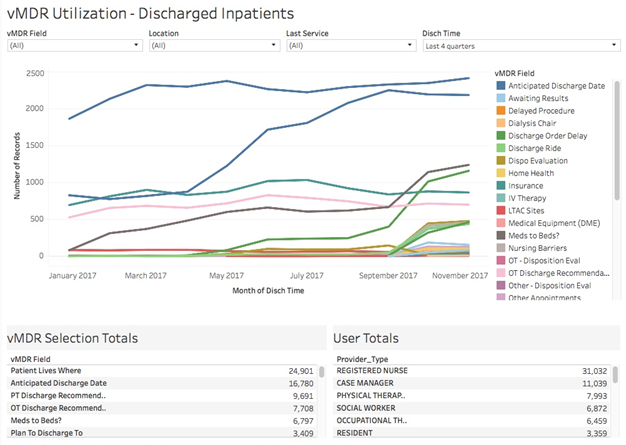Background: Reducing length of stay to improve access, minimize hospital-associated morbidity, and reduce cost is a top priority at many hospitals. Information about barriers and delays impacting discharge (i.e., arranging subacute nursing facility placement, setting up a new dialysis seat, receiving consult recommendations for discharge) is rarely documented and often obtained anecdotally or qualitatively. This lack of standardization makes it challenging to quantify the impact of barriers, track progress regarding their reduction, and allocate additional resources. Traditionally, clinical informatics initiatives have focused on using electronic medical record (EMR) data to improve clinical care rather than meet operational imperatives. However, this data has the potential to meet both needs. A virtual multidisciplinary rounding tool (vMDR), originally designed as a vehicle to facilitate and improve asynchronous communication among physicians, nurses, therapists, social workers, and case managers, has the potential to quantify discharge barriers, guide process improvement initiatives, and improve resource allocation.
Purpose: The aim of this project is to utilize data available in the EMR through our vMDR tool to diagnose key barriers to discharge and use this information to drive continuous operational improvement and resource allocation.
Description: A team of physicians, social workers, case managers, informatics experts, data analysts, and hospital leadership was assembled to develop a vMDR tool to facilitate asynchronous communication among various providers. The tool provides a centralized repository for information pertaining to patient discharge and has been rolled out hospital-wide. Figure 1 provides a screenshot highlighting the discharge readiness elements captured by the tool. Using the tool in this method has been well received by the hospital and resources have been deployed to establish its use in this fashion. Online interactive dashboard reports, an example of which is shown in Figure 2, were then developed to evaluate patterns in potential barriers and to quantitatively track their time to resolution. Targeted interventions were implemented to systematically address the most common barriers.
Conclusions: Quantitative insights into discharge barriers can be gained through review of data generated by an EMR based multidisciplinary rounding tool, thus facilitating operational improvements and targeted resource allocation.
.png)

